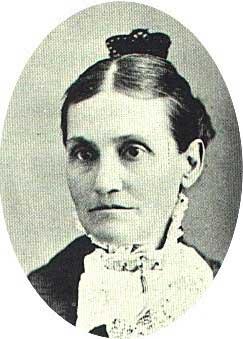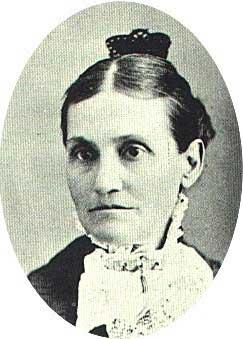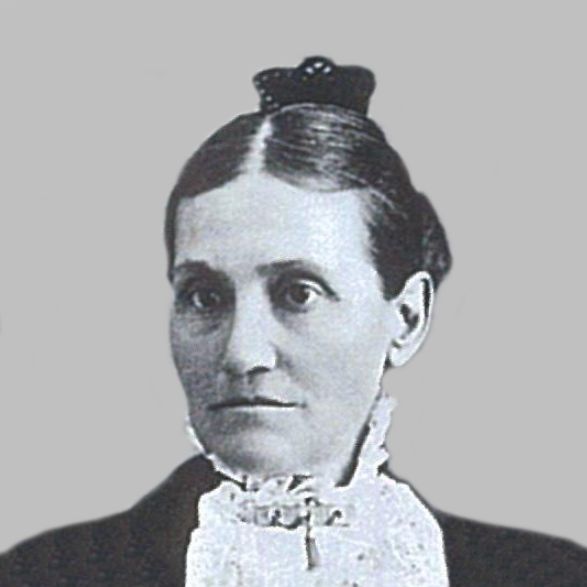Daughter of Sanford Porter and Nancy Warriner
Married Edward Stevenson, 7 Apr 1845, Nauvoo, Hancock, Illinois
Children - Joseph Echo Porter Stevenson, Edward Alonzo Stevenson, Eliza Stevenson, Nephi Porter Stevenson, Elizabeth Nancy Stevenson
Married Ezra Thompson Clark, 11 Jul 1870, Salt Lake City, Salt Lake, Utah
History - It took Nancy nearly sixty years to get from Ohio to Utah to Cache Valley and into the art of sericulture, or the raising of silkworms.
With her family, Nancy helped push the American frontier westward, traveling in a flatboat on rivers, crossing the land in wagons, sleeping in the protection of a hollow tree, and camping on frozen rivers with ice eight to ten inches thick. They moved to Illinois, to Missouri, where Nancy was baptized, to Iowa across the river from Nauvoo. It was here that Nancy met Edward Stevenson and Ezra T. Clark, both suitors for her hand. She married Edward in the Nauvoo Temple, April 7, 1845, and by June 1846, two years after the Prophet Joseph Smith's murder, they were with the main company leaving Nauvoo for Council Bluffs, Iowa, where their first child was born.
Joining the Charles C. Rich Company, they crossed the Plains, arriving in Salt Lake City on October 2, 1847. They made their log home in Salt Lake, where four children were born to them. Edward was called to do extensive missionary service in Gibraltar, his birthplace, and in Canada, Mexico, Europe and parts of America. By 1857, when Nancy's fifth child was born, Edward had taken two other wives, one of whom seemed to receive favoritism. Not surprisingly, this caused domestic problems. Consequently, at Brigham Young's arrangement, Nancy's second husband became Ezra T. Clark. Thus it was that Nancy became the wife of both of her two early suitors.
Ezra took Nancy to Farmington in 1870 to a home on Clark Street near his other two wives. She was creative and involved in sericulture (raising silkworms to produce raw silk), and is credited with making the first silk in Utah, which she donated to the Logan Temple building fund. Ultimately this silk was purchased and presented to Eliza R. Snow. It became the first silk dress produced in Utah.
When Ezra T. Clark was called to colonize the Bear Lake area, he established a home at mid-point in Logan, and that is what brought Nancy to Cache Valley where she was appointed as the first matron-supervisor of the Logan LDS Temple. She was called to Elba, Idaho, to assist her son and his little family, where she contracted pneumonia, November 1888, which re-suited in her death. Ezra brought her back to Farmington for burial.
Nancy's entire life was shaped by her unselfish service to her loved ones and fellowmen, and dedication to the gospel. The pioneers' struggle for existence, the problems of plural marriage, the loving responsibility of raising her family alone most of the time, survival through all this with a sustaining love for the Lord--all these things show the tapestry and quality of Nancy's character, and carved for her a place in the mosaic of Utah's stalwart pioneer women.
An Enduring Legacy, Volume Eight, p. 278
Daughter of Sanford Porter and Nancy Warriner
Married Edward Stevenson, 7 Apr 1845, Nauvoo, Hancock, Illinois
Children - Joseph Echo Porter Stevenson, Edward Alonzo Stevenson, Eliza Stevenson, Nephi Porter Stevenson, Elizabeth Nancy Stevenson
Married Ezra Thompson Clark, 11 Jul 1870, Salt Lake City, Salt Lake, Utah
History - It took Nancy nearly sixty years to get from Ohio to Utah to Cache Valley and into the art of sericulture, or the raising of silkworms.
With her family, Nancy helped push the American frontier westward, traveling in a flatboat on rivers, crossing the land in wagons, sleeping in the protection of a hollow tree, and camping on frozen rivers with ice eight to ten inches thick. They moved to Illinois, to Missouri, where Nancy was baptized, to Iowa across the river from Nauvoo. It was here that Nancy met Edward Stevenson and Ezra T. Clark, both suitors for her hand. She married Edward in the Nauvoo Temple, April 7, 1845, and by June 1846, two years after the Prophet Joseph Smith's murder, they were with the main company leaving Nauvoo for Council Bluffs, Iowa, where their first child was born.
Joining the Charles C. Rich Company, they crossed the Plains, arriving in Salt Lake City on October 2, 1847. They made their log home in Salt Lake, where four children were born to them. Edward was called to do extensive missionary service in Gibraltar, his birthplace, and in Canada, Mexico, Europe and parts of America. By 1857, when Nancy's fifth child was born, Edward had taken two other wives, one of whom seemed to receive favoritism. Not surprisingly, this caused domestic problems. Consequently, at Brigham Young's arrangement, Nancy's second husband became Ezra T. Clark. Thus it was that Nancy became the wife of both of her two early suitors.
Ezra took Nancy to Farmington in 1870 to a home on Clark Street near his other two wives. She was creative and involved in sericulture (raising silkworms to produce raw silk), and is credited with making the first silk in Utah, which she donated to the Logan Temple building fund. Ultimately this silk was purchased and presented to Eliza R. Snow. It became the first silk dress produced in Utah.
When Ezra T. Clark was called to colonize the Bear Lake area, he established a home at mid-point in Logan, and that is what brought Nancy to Cache Valley where she was appointed as the first matron-supervisor of the Logan LDS Temple. She was called to Elba, Idaho, to assist her son and his little family, where she contracted pneumonia, November 1888, which re-suited in her death. Ezra brought her back to Farmington for burial.
Nancy's entire life was shaped by her unselfish service to her loved ones and fellowmen, and dedication to the gospel. The pioneers' struggle for existence, the problems of plural marriage, the loving responsibility of raising her family alone most of the time, survival through all this with a sustaining love for the Lord--all these things show the tapestry and quality of Nancy's character, and carved for her a place in the mosaic of Utah's stalwart pioneer women.
An Enduring Legacy, Volume Eight, p. 278
Advertisement
Records on Ancestry
Sponsored by Ancestry
Advertisement



